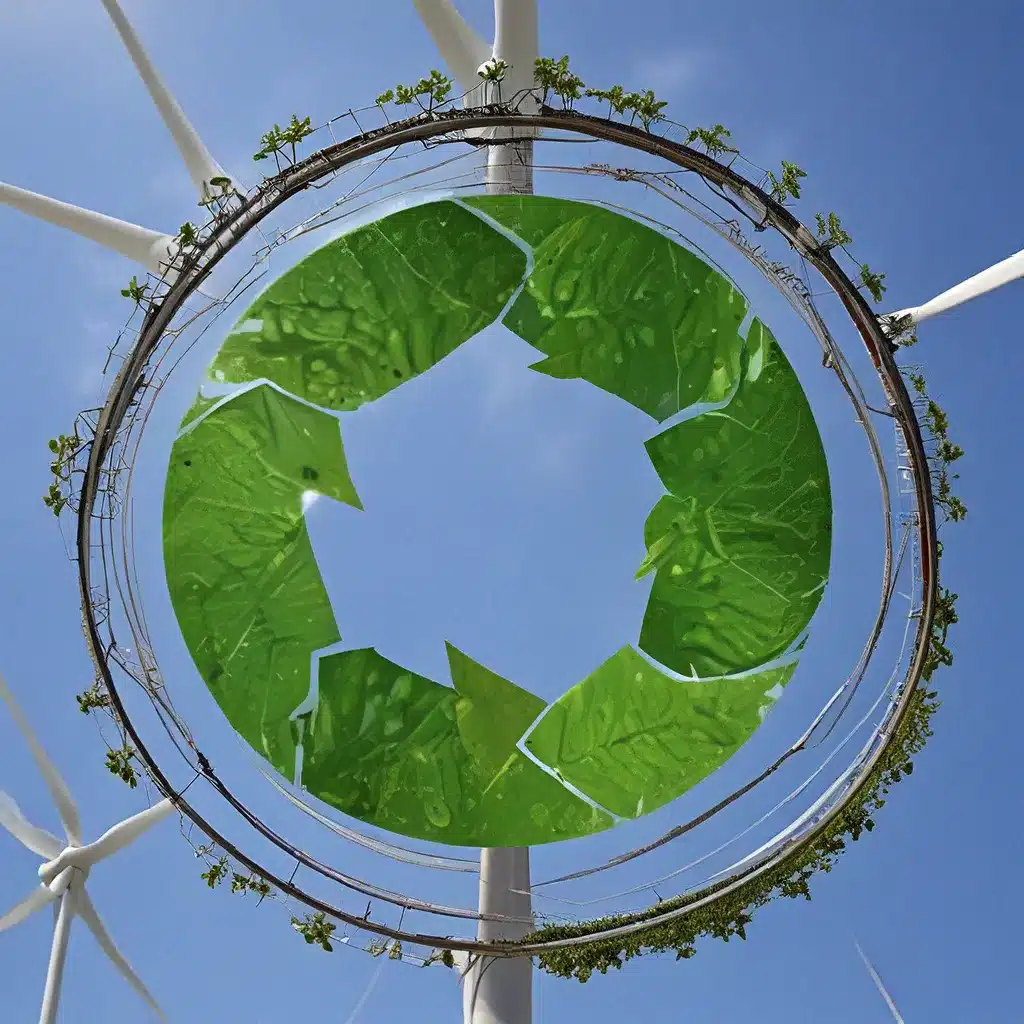
As someone who’s deeply passionate about sustainability, I’ve been fascinated by the growing intersection between renewable energy and the circular economy. It’s like a match made in eco-heaven – two powerful concepts that, when combined, have the potential to transform our world into a greener, more resilient place.
Let me tell you, the circular economy is no mere buzzword. It’s a game-changing systems-level approach that tackles global challenges like climate change, biodiversity loss, waste, and pollution head-on. The basic idea is simple: we need to stop treating our precious resources as if they’re disposable and start keeping them in circulation, recycling and repurposing them at their highest value.
And you know what? Renewable energy is a crucial enabler of this circular transition. By providing clean, renewable power, it helps us decouple economic activity from the consumption of finite resources, a key tenet of the circular economy. It’s a synergistic relationship that’s just too good to ignore.
So, buckle up, my friends, because I’m about to take you on a deep dive into this dynamic duo and show you how they’re teaming up to create a brighter, more sustainable future. Trust me, it’s going to be a wild ride!
Renewable Energy: Powering the Circular Shift
Let’s start with the renewable energy side of the equation. We all know that fossil fuels have been the backbone of our energy system for far too long, contributing to the alarming rise in greenhouse gas emissions that are fueling climate change. But thanks to advancements in technology and a growing global commitment to sustainability, renewable sources like solar, wind, and hydropower are quickly gaining ground.
And the best part? Renewable energy is the perfect complement to the circular economy. By providing clean, sustainable power, it helps us break free from the linear “take-make-waste” model that’s been wreaking havoc on our planet. Instead, we can focus on closing the loop, keeping resources in circulation and minimizing waste and pollution.
Just imagine a world where our homes, businesses, and entire cities are powered by renewable energy. It’s a world where we can manufacture products, transport goods, and power our daily lives without the guilt of contributing to climate change. A world where the energy we use is in harmony with the natural cycles and rhythms of our planet.
The Circular Economy: Closing the Loop
Now, let’s dive deeper into the circular economy and how it’s revolutionizing the way we think about resources and waste.
The Ellen MacArthur Foundation, a leading authority on the circular economy, defines it as a system that “eliminates waste and pollution, circulates products and materials at their highest value, and regenerates nature.” In other words, it’s all about rethinking the entire lifecycle of products and materials, from design to disposal, to ensure that nothing goes to waste.
This is in stark contrast to the linear economy we’ve been stuck in for far too long, where we extract resources, manufacture products, and then discard them as waste. It’s a wasteful and unsustainable model that’s putting tremendous strain on our planet’s finite resources and natural ecosystems.
But the circular economy offers a better way forward. By designing products for longevity, repairability, and recyclability, we can keep materials in circulation for as long as possible, minimizing the need for new resource extraction. And by embracing renewable energy, we can power this circular system with clean, sustainable energy, further reducing our environmental impact.
The Synergies: Renewable Energy and Circular Economy in Action
Now, let’s explore how these two powerful concepts work together to create a more sustainable future.
One of the key synergies is in the built environment. The construction and operation of buildings are responsible for a significant portion of global greenhouse gas emissions and resource use. But by integrating renewable energy into the design and construction of buildings, we can dramatically reduce their environmental footprint.
And it doesn’t stop there. The circular economy principles of design for disassembly, material reclamation, and waste minimization can also be applied to the built environment, ensuring that buildings are constructed, maintained, and eventually deconstructed in a way that maximizes the reuse and recycling of materials.
Another area where renewable energy and the circular economy shine is in the food system. Food waste is a major problem, with an estimated one-third of all food produced globally going to waste. By using renewable energy to power innovative food preservation and distribution technologies, we can reduce this waste while keeping nutrients and materials in circulation.
And let’s not forget about the transportation sector. As we transition to electric vehicles powered by renewable energy, we’re not only reducing emissions but also creating opportunities for battery recycling and reuse, a critical component of the circular economy.
The Future is Circular and Renewable
As I’ve hopefully demonstrated, the marriage of renewable energy and the circular economy is a match made in sustainability heaven. By harnessing the power of clean, renewable energy and rethinking the way we produce, consume, and dispose of resources, we can create a future that’s truly sustainable, resilient, and regenerative.
But this transition won’t happen overnight. It’s going to require a collective effort from policymakers, businesses, and individuals to make the necessary changes. We need bold, visionary leadership to set the right policies and incentives, and we need innovative businesses to develop the technologies and business models that will drive this transformation.
And of course, we need engaged and empowered citizens like you to make sustainable choices, support circular and renewable initiatives, and be the change we want to see in the world.
So, what are you waiting for? Let’s roll up our sleeves and get to work, building a future where renewable energy and the circular economy work hand in hand to create a greener, more prosperous world for all. Who knows, we might just have some fun along the way!

